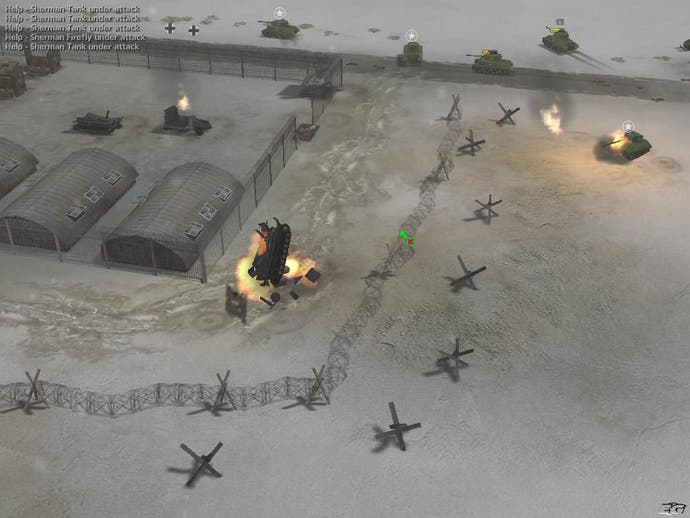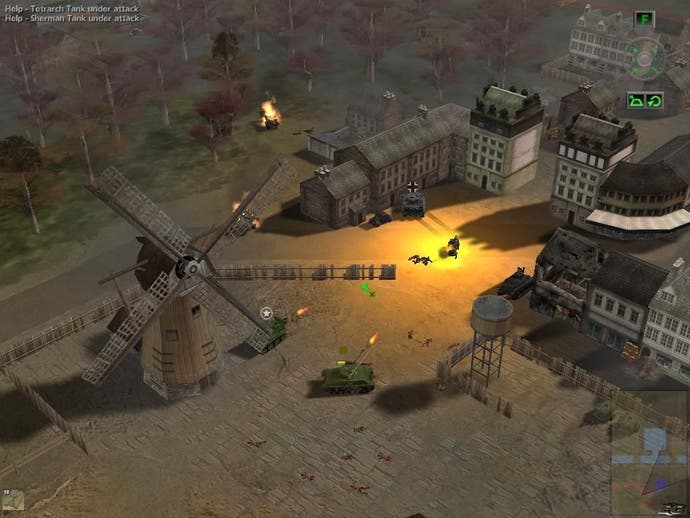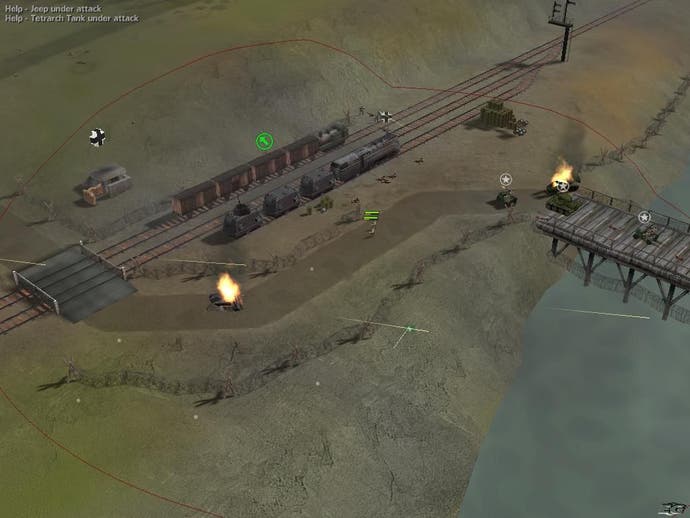World War II: Frontline Command
The Bitmaps are back on form, says Rob
World War II has come to London. The roar of artillery mixes with the chatter of small arms fire and the shouts of the soldiers. The bodies of the slain litter the crater-pockmarked earth, while the flames of burning buildings and destroyed armour divisions cast eerie flickering light on structures still standing. Half tracks and tanks churn grassy fields into muddy quagmires, and you can almost smell the heavy scents of cordite and death on the air.
This is no dystopian alternate reality, though, because on the banks of the placid Thames, one of the UK's most famous development studios is recreating the battlefields of Europe in one of the most promising strategy games we've ever laid eyes on. As the sluggish waters of the river flow past the windows of their wharfside offices, the guys and gals of the Bitmap Brothers bring to life the invasion of Fortress Europe as the development of World War II: Frontline Command enters its final stages.

Dulce et Decorum Est
The Second World War is en vogue at the moment among game developers, thanks in no small part to the massive success of the Medal of Honor (sic) series. Strategy games set in the era, however, have uniformly been extremely hardcore affairs - with CDV's Sudden Strike titles being the closest thing to a mass-market WW2 strategy game in the past few years. The team at the Bitmap Brothers is determined to change all that, and WW2 Frontline Command looks set to achieve the twin goals of pleasing both casual strategy fans and hardcore WW2 nuts with a combination of playability, superb graphics, a slick interface and incredible attention to detail.
The game covers the period from D-Day through to VE-Day, with early missions involving softening up the German defences in Normandy and leading your troops up Omaha beach leading on to campaigns throughout Europe. Wisely, the team has chosen to stray a little from the traditional beaten path of WW2 games and has focused on less-known encounters, allowing them to make adjustments for playability without running the risk of annoying war buffs by altering well-known historical situations. However, all the famous battles are present and correct, including Omaha Beach, Operation Market Garden, the Battle of the Bulge, breaching the Siegfried Line and, of course, the final Allied assault on the Eagle's Nest.
More historical accuracy comes courtesy of the range of units available in the game, which the designers claim is an exhaustively comprehensive collection of every piece of military kit that saw service in these theatres of war. The range of units on offer is certainly fantastically varied, and the type of armour and weaponry on each unit has been researched meticulously by the team - even to the degree that units have accurate depictions of weak armour patches. Tanks, for example, generally have significantly stronger armour on the front than on the back and sides - and sometimes a critical hit to the turret will prevent it rotating, thus crippling the machine by giving it a small fixed field of fire.

Conscript Boot Camp
The game offers two very different modes of play, namely Recruit and Veteran. Although these two modes do broadly reflect the difficulty levels of the game, the differences run a lot deeper than the number of enemy units or intelligence of the enemy AI. The Recruit mode is a much more arcade-style experience; your infantry units gradually regain their health after battles and have unlimited supplies of ammunition, for example. In Veteran mode - which is a 25 stage campaign divided into five distinct segments, as opposed to the 12 stage linear campaign in Recruit mode - ammunition is a major consideration, and while your infantrymen do regain health over time, it happens with agonising slowness. Veteran mode also introduces the game's critical hit system, which can necessitate mid-battle repairs to your units.
One element of the campaigns which deserves a special mention is the final levels at the end of each segment - or rather, the unusual system which allows you to influence how these levels play out during earlier battles. Your actions early in the game - particularly in regard to secondary objectives - will trigger special events on these later levels, so for example taking out a battery of anti-aircraft guns in one level could earn you a much-needed parachute drop of troops three levels down the line. It's a unique method of rewarding players for completing secondary objectives, and one which lends an interesting air of continuity to the proceedings.
Another interesting factor of the gameplay is the troop morale system, which will be familiar to players of serious wargames but perhaps less so for general RTS gamers. Your troops gain morale by being near each other, and they gain a lot of morale by being near a command unit (I guess the battlefield is a very odd place, since I know fairly few people who get a morale boost by having their boss stood next to them); but being alone or losing skirmishes saps morale heavily, affecting the weapons accuracy and overall combat effectiveness of the unit. Very low morale causes units to "go hedgehog", as the designers describe it, a state in which troops curl up on the ground and cry (although they will still follow orders, unlike the infuriatingly lily-livered soldiers in the Close Combat series); very high morale can cause "hero mode", where amazing feats of bravery or critical hits are much more likely to occur.

Play it by ear
It's all very well to describe the interesting gameplay features, I hear you cry, but what is the actual basic gameplay itself like? Well, utilising the magical Eurogamer videogame cocktail shaker, the answer is that it's like a mix of equal parts of Sudden Strike and Close Combat, shaken up with a dash of Commandos 2 and served with a garnish of C&C Generals' graphics engine. Each level, in case you hadn't worked this out already, gives you a certain fixed number of troops and armour with which to complete your objectives. There's no resource management, no construction and no harvesting, making this a pure strategic combat sim - your only resources are the troops under your command, and using them wisely is the only way to progress.
As such, the combat model is a lot richer and more interesting than you'll find in most strategy games. Line of sight is a vital element of the game, and it's a system that's modelled almost perfectly by Frontline Command. Troops standing up behind a hedge can see into the field beyond - and equally, can be seen by anyone on the other side - but crawling along the ground next to a hedge renders both you and the enemy blind. Tanks have a conical field of vision rather than a circular one, giving skilled players a chance to slip an engineer up behind one and destroy it with an explosive charge, and perhaps best of all, commanders and snipers have binoculars which can be activated to sweep the nearby landscape for enemy units, or to "spot" for mortar or other artillery using the game's shared field of vision system.
This accurately modelled sight system is perhaps one of the most interesting parts of Frontline Command, because it opens up a variety of new tactics which don't really work in other strategy games. Proper ambushes are a vital part of the game - ranging from simple traps in urban areas to having a row of grenadiers pop up from behind a hedgerow as an enemy tank thunders past. Spotting for your artillery is also of great importance; you'll often find yourself sneaking a command unit up towards enemy lines so that your heavy guns can be brought into play using shared line of sight. What you can't see, you can't attack - and thankfully, the computer AI plays fair on this score, so you'll never find that your carefully planned ambush goes to pot because the enemy mysteriously knew your position.

A terrible beauty
If you're going to depict slaughter, destruction and suffering, the least you can do is make it look nice - and the team at the Bitmap Brothers have certainly achieved that. Frontline Command stands head and shoulders over any other game in its class, with extremely well done, fully rotating and zoomable 3D maps and units, complete with great dynamic lighting effects, impressive explosions and detailed models. The game isn't quite as good looking as C&C Generals, but it's got significantly more artistic flair and best of all, it runs like a dream on systems on which Generals would be dropping frames all over the place.
Overall, Frontline Command is looking very good indeed, and we were very impressed with the broad appeal of the game. There really is something for everyone here; anyone who enjoyed Sudden Strike will almost certainly love Frontline Command, as will anyone who got into Commandos (although it's quite a different game really). Casual PC RTS fans will also find a lot to enjoy in this game, and perhaps this is the biggest achievement of the title, if the team can pull it off - it looks set to be a game which makes the WW2 realistic strategy genre accessible to the average gamer without alienating the hardcore.
The version of Frontline Command which the developers showed us wasn't completely finished, but it was very close indeed, and only balancing, tweaking and bugfixes remain on the to-do list before the May 2nd ship date of the game. We'll let you know our final thoughts on the game closer to the release date.
World War II: Frontline Command screenshots (PC)

